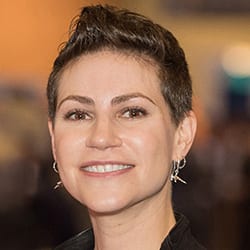The Future Learning Ecosystem with Sae Schatz
Description
Throughout her career, Sae Schatz has been deeply immersed in the application and advancement of learntech. She currently serves as director of the Advanced Distributed Learning (ADL) Initiative, a government program for science, technology, and policy related to distributed learning. She’s also an editor of and contributor to the e-book Modernizing Learning: Building the Future Learning Ecosystem.
Prior to joining ADL, Sae worked as an assistant professor and an applied human-systems scientist, with an emphasis on human cognition and learning, instructional technologies, adaptive systems, human performance assessment, and modeling and simulation.
In this third episode in our seven-part series on the frontiers of learning technology, Jeff talks with Sae about ADL’s “building the future learning ecosystem” initiative and the key ideas behind it. They also discuss the role of Total Learning Architecture (TLA), data, the future of learntech, and suggestions for learning businesses to capitalize on these new technologies.
To tune in, just click below. To make sure you catch all future episodes, be sure to subscribe via RSS, Apple Podcasts, Spotify, Stitcher Radio, iHeartRadio, PodBean, or any podcatcher service you may use (e.g., Overcast). And, if you like the podcast, be sure to give it a tweet.
Listen to the Show
Access the Transcript
Download a PDF transcript of this episode’s audio.
Read the Show Notes
[00:29 ] – Intro and background info about Sae Schatz
[01:31 ] – About ADL, the work it does, and Sae’s role
Sae shares that the Advanced Distributed Learning (ADL) Initiative was created in the late 1990s to encourage the use of online learning, across the government and society and, in particular, defense.
Originally, a lot of the work focused on what we now see as “traditional” e-learning—learning management systems and SCORM (Shareable Content Object Reference Model), for example.
They also do a lot of work with digital learning interoperability, data, emerging platforms, and the learning science for different modalities.
The Evolution of xAPI and cmi5
[02:58 ] – How are xAPI or cmi5 evolving? What other specifications are you working on?
Besides xAPI (the Experience Application Programming Interface) and cmi5, Sae says the ADL is working on other interoperability specifications, dealing with learning content metadata, learner records, and competencies. These are all ways to be able to put building blocks together.
She notes we have been talking about these emerging concepts for years: lifelong learning (see Chris Dede’s discussion on the 60-Year Curriculum), ubiquitous learning across all different kinds of platforms, augmented reality, virtual reality, extended reality, data-driven learning, AI-driven personalization, learning analytics, and competency-based learning.
The question really becomes how do we take all these amazing puzzle pieces and put them together? And that’s really where all of these different interoperability specifications come into play. Think of that sort of like Lego blocks. The reason that Legos work is because you have the exact same little connections in the same sizes in the same places. But the blocks themselves can be all different shapes and formats, and you can build your own little castle, however you want it to be. The art is in the way that they’re interoperable.
Sae Schatz
Frontiers of Learning Technology: Building the Future Learning Ecosystem
[05:45 ] – When you think about the phrase “frontiers of learning technology,” what comes to mind?
Sae shares the ADL is very focused right now on building “the future learning ecosystem”—the K-to-gray, technology-enabled, data-driven, heterogeneous system of systems. Imagine a technology-enabled lifelong continuum of learning that’s driven by data, that’s personalized, and that incorporates good-quality learning science.
The ADL recently published the (free and downloadable) e-book Modernizing Learning: Building the Future Learning Ecosystem, which talks about the rationale and then defines a roadmap across technology, data, and data issues like privacy and security, learning science, and organizational dynamics.
[07:33 ] – How do we make progress towards building this future of learning ecosystem?
Sae explains that won’t get there all at once; it has to be a journey. But we don’t have to get all the way to the end to begin to realize some benefits.
She shares three steps to making progress:
- Data interoperability. Currently we have learning islands that are pretty siloed. One particular course doesn’t know who you are or what courses that you took beforehand.
We don’t have a way to have that relay race, where we’re passing the baton of data, of information about the learner from place to place to place. Instead of having these learning islands, we want to connect them up. We want to get to that modular open systems architecture, that interoperability.
Sae Schatz
- Semantic interoperability. This helps us get a common currency across the different islands, and it’s where competency-based learning comes into play, so can all work off a common, machine-readable list of the different knowledge, skills, abilities, and job requirements.
- Upskill learning professionals. We’re not living on our own little island anymore; instead we have this whole world we need to navigate. We need to have learning engineers—people who understand technology, learning data, learning analytics, learning science for learning at scale, lifelong learning, and all of these other capabilities to use our toolset to the best effect.
Total Learning Architecture (TLA)
[11:25 ] – Would you tell us about the Total Learning Architecture (TLA) concept?
TLA is about data interoperability and the enabling infrastructure to make this big vision work. Specifically, TLA is a set of IT and data specifications and standards for learning technologies. TLA is open and standards-based, so anyone can implement it in their systems. It’s the blueprint detailing where those little circles on the Lego blocks go.
The Total Learning Architecture incor







